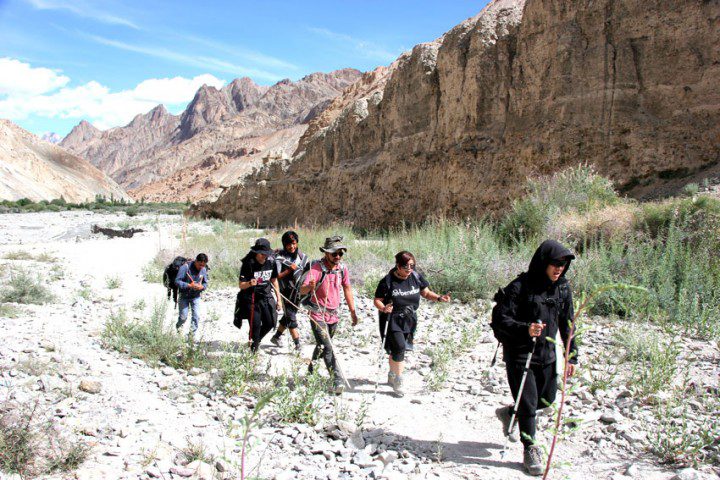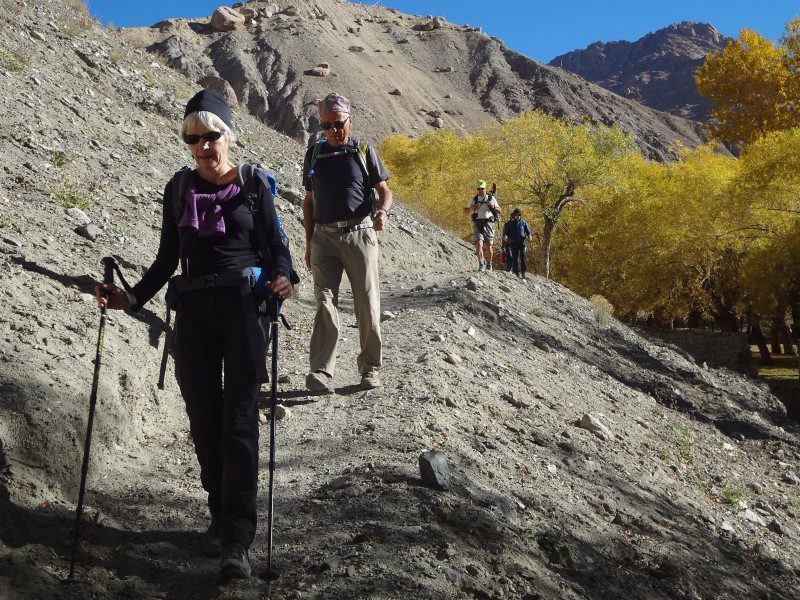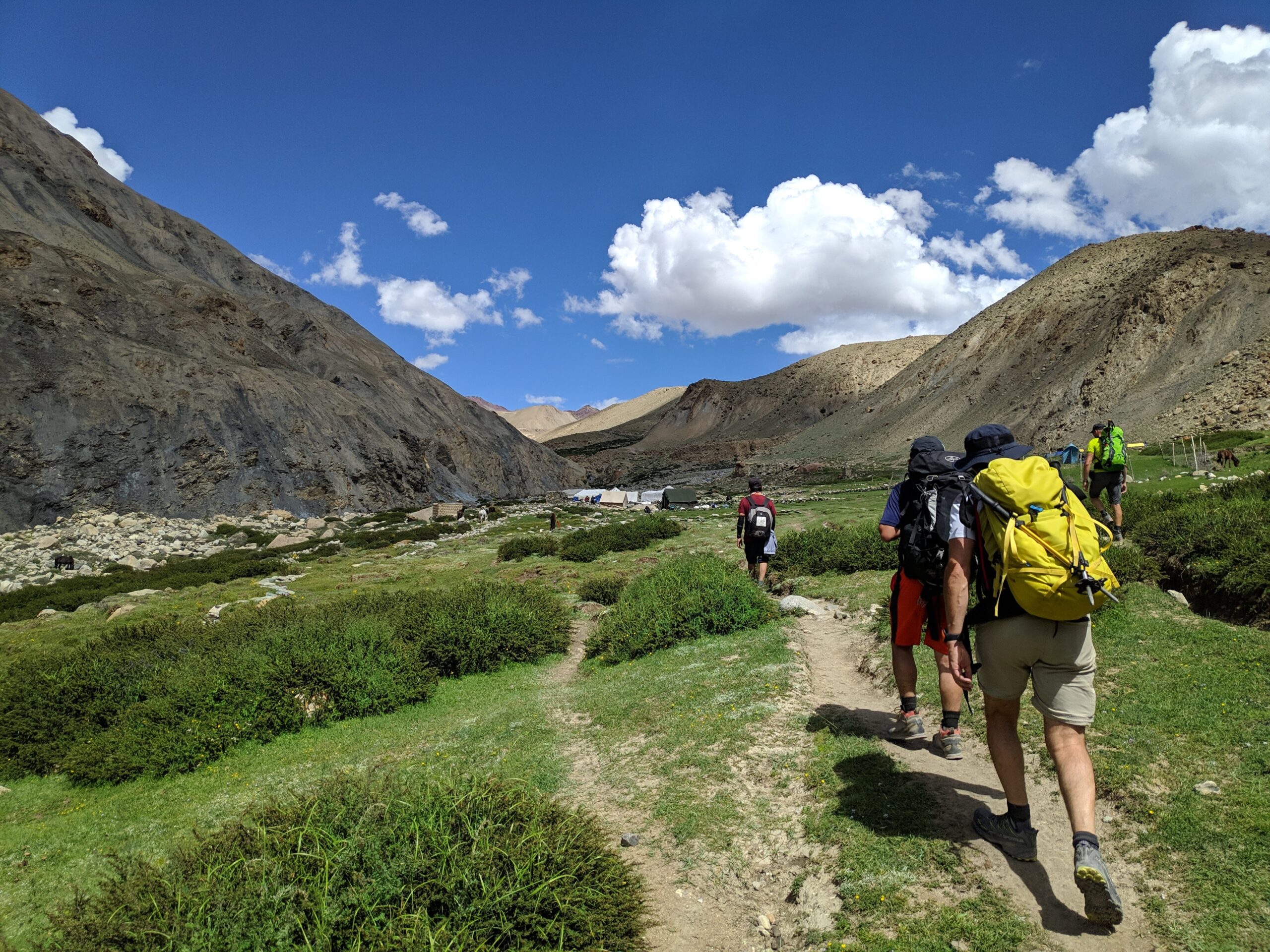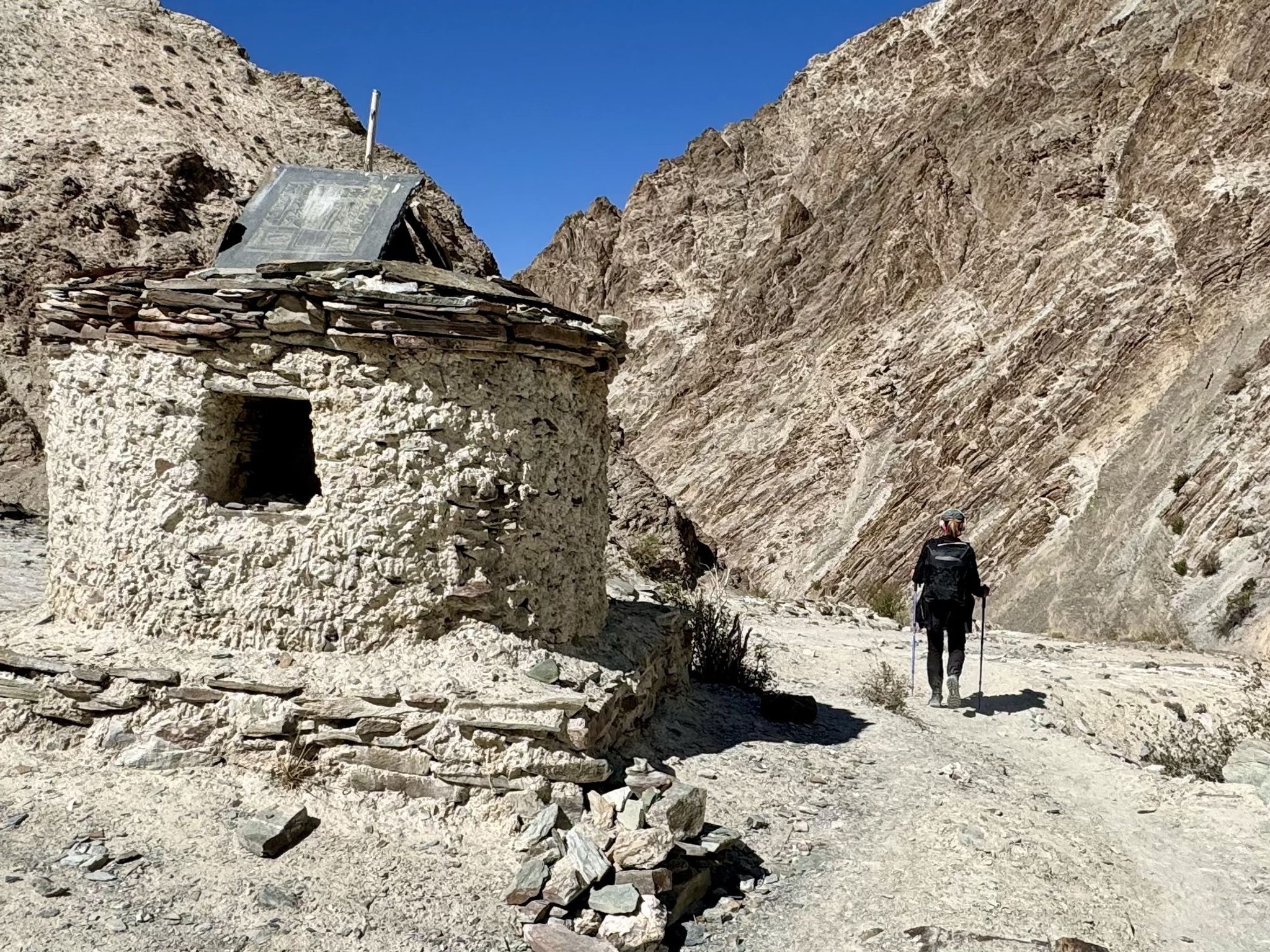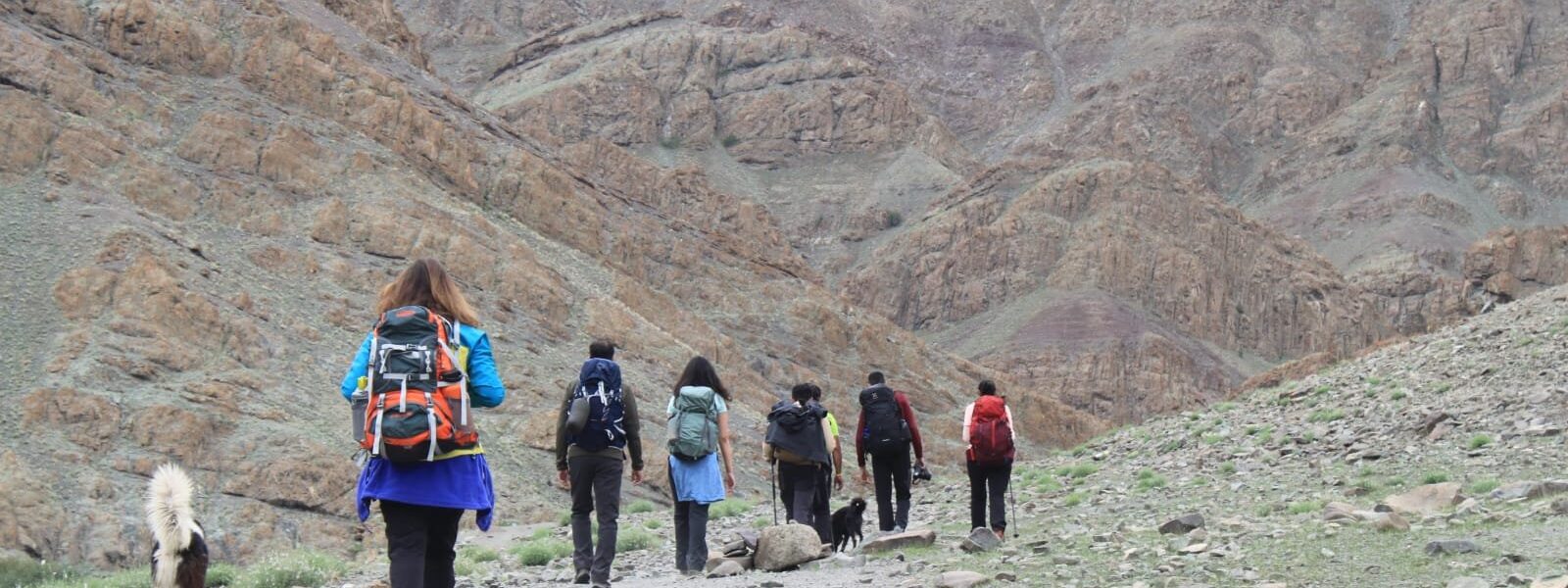Ladakh, often referred to as the “Land of High Passes,” is one of India’s most breathtaking regions for trekking. From its dramatic mountain landscapes to its rich cultural heritage, Ladakh is a must-visit destination for trekkers and adventure seekers. This 14-day trekking itinerary is designed for travelers who want to immerse themselves in the beauty of Ladakh while challenging themselves on some of the best trekking routes in the Himalayas.
In this blog, we’ll take you through a comprehensive day-by-day Ladakh trekking itinerary that covers the most scenic and culturally significant areas, providing the perfect blend of adventure, culture, and natural beauty. We’ve also included travel days by car, necessary acclimatization stops, and customer testimonials to give you an authentic glimpse of this unforgettable experience.
Why Ladakh is a Trekker’s Paradise
Ladakh’s high-altitude desert is a place of extremes—stark, remote, and immensely beautiful. Nestled between the Himalayan range and the Karakoram range, the region offers a variety of trekking routes that cater to all levels of trekkers.
Exploring the Unique Landscape of Ladakh
From snow-capped peaks to barren valleys, the landscape of Ladakh is incredibly diverse. Trekkers are treated to constantly changing scenery, including rugged mountains, expansive plateaus, glacial rivers, and hidden villages. This vast diversity in terrain makes Ladakh a trekker’s paradise, offering both natural beauty and cultural immersion.
“The landscape of Ladakh is beyond words. Every day of the trek was like stepping into a new world. I’ve never experienced such diversity in one place!”
— John Thompson, Canada, Travel Blogger
Adventure Awaits: Best Time for a Ladakh Trek
The best time to trek in Ladakh is during the summer months, from June to September, when the weather is ideal for trekking. The region remains relatively dry, with clear skies and mild temperatures during the day. However, nights can get cold, especially at higher altitudes, so it’s essential to pack wisely.

Preparing for a 14-Day Trek in Ladakh
Essential Trekking Gear for Ladakh
Packing the right gear is crucial for a successful trek. Below is a list of essential items you should carry:
| Item |
Description |
| Trekking Boots |
High-ankle, waterproof boots for rugged terrain |
| Warm Clothing |
Thermal layers, fleece jackets, and windproof pants |
| Sleeping Bag |
Rated for at least -10°C (camping nights will be cold) |
| Trekking Poles |
Helps with balance on steep ascents and descents |
| Sunscreen & Sunglasses |
The high-altitude sun is harsh; protect your skin |
| First-Aid Kit |
Basic medical supplies including altitude sickness meds |
“I was so glad I brought my heavy-duty sleeping bag—those cold nights in the mountains can catch you off guard if you aren’t prepared.”
— Laura Stevens, UK, Outdoor Enthusiast
How to Acclimatize to Ladakh’s High Altitude
The biggest challenge of trekking in Ladakh is altitude acclimatization. At elevations ranging from 3,500 to 5,000 meters, acclimatizing is essential to prevent altitude sickness. Spend at least two days in Leh before starting the trek to allow your body to adjust.
Tips for Acclimatization:
- Stay hydrated: Drink plenty of water and avoid alcohol.
- Ascend gradually: Plan your trek so that the altitude increases slowly.
- Take it easy: Don’t exert yourself too much during the first few days.
Physical and Mental Preparation for a Ladakh Trek
You don’t need to be a professional athlete to enjoy trekking in Ladakh, but a reasonable level of fitness will make the trek more enjoyable. Focus on cardiovascular training (like running or cycling) and leg strength exercises to prepare for the long days of walking.

Detailed 14-Day Ladakh Trekking Itinerary
Day 1-2: Arrival in Leh & Acclimatization
Arrival in Leh: Spend the first two days in Leh (3,500 meters) to acclimatize to the altitude. Use this time to explore the town’s monasteries, markets, and nearby attractions like Thiksey Monastery and Shanti Stupa. It’s essential to keep your activity levels light as your body adjusts.
“Leh was the perfect introduction to Ladakh. The monasteries are stunning, and the people are incredibly welcoming.”
— Maria Gonzales, Spain, Teacher
Day 3-6: Markha Valley Trek
The Markha Valley trek is one of Ladakh’s most popular and scenic routes, showcasing the region’s cultural richness and natural beauty. You’ll trek through traditional Ladakhi villages, visit ancient Buddhist monasteries, and cross high-altitude passes.
- Day 3: Drive from Leh to Zinchen (1 hour) and trek to Yurutse.
- Day 4: Trek from Yurutse to Skiu.
- Day 5: Trek from Skiu to Markha Village.
- Day 6: Trek from Markha to Hankar, passing by the Tachungtse Monastery.
“Markha Valley is a hidden gem. The mix of cultural experiences with the dramatic landscape is something I’ll never forget.”
— David Kim, USA, Photographer
Day 7: Drive to Likir
After completing the Markha Valley trek, you’ll drive from Hemis to Likir, which takes about a full day. Likir is famous for its Likir Monastery, a stunning sight amidst the mountains. This day is a rest day, allowing your body to recover before the next leg of the journey.
Day 8-11: Sham Valley Trek
The Sham Valley trek is a moderate trek suitable for trekkers looking for a more relaxed pace. Also known as the “Baby Trek”, it passes through villages and monasteries, making it a cultural as well as scenic experience.
- Day 8: Trek from Likir to Yangthang.
- Day 9: Trek from Yangthang to Hemis Shukpachan.
- Day 10: Trek from Hemis Shukpachan to Tingmosgang.
- Day 11: Trek from Tingmosgang to Ang.
“The Sham Valley trek was a perfect mix of culture and trekking. We stayed in homestays, which added a personal touch to the whole experience.”
— Akiko Tanaka, Japan, Engineer
Day 12: Return to Leh by Car
After completing the Sham Valley trek, you’ll return to Leh by car. This is a day for relaxation and perhaps some last-minute shopping in Leh’s bustling markets. Enjoy a leisurely evening in Leh, soaking in the views one last time.
Day 13-14: Explore Leh and Departure
On Day 13, you can explore more of Leh or visit nearby monasteries, such as Spituk Monastery or Hemis Monastery, which is one of the largest and most famous monasteries in Ladakh. Day 14 marks the end of your journey, and you’ll fly out of Leh, taking with you unforgettable memories of your Ladakh trek.

Understanding Ladakhi Culture and Wildlife During the Trek
Encountering Ladakhi Villages Along the Trekking Route
Ladakhi villages, nestled in the high-altitude valleys, offer a glimpse into the traditional life of the region’s people. As you trek through villages like Markha and Hemis Shukpachan, you’ll experience Ladakhi hospitality through homestays and get a deeper understanding of Buddhist culture.
Wildlife and Nature on the Trekking Trail
Ladakh is home to unique wildlife, including the blue sheep, Himalayan marmot, and the elusive snow leopard. Keep your eyes peeled for these animals as you trek through the high mountain passes.
Important Trekking Tips for Your Ladakh Adventure
How to Obtain Trekking Permits for Ladakh
Foreign travelers require an Inner Line Permit (ILP) for trekking in certain areas of Ladakh. These permits are easily available in Leh at the District Magistrate’s Office or through travel agencies.
Guided Treks vs. Solo Treks in Ladakh
While it’s possible to trek solo in Ladakh, we recommend hiring a guide or joining a group for safety reasons, especially on high-altitude routes.
Budgeting for a 14-Day Trek in Ladakh
The total cost of a 14-day trek in Ladakh depends on whether you join a guided tour or go independently. On average, a guided trek costs around $50 to $100 per day, covering accommodation, food, and permits.

Frequently Asked Questions (FAQs)
What is the Best Time to Trek in Ladakh?
The best time for trekking in Ladakh is from June to September, when the weather is clear, and the roads are accessible.
How Difficult is a 14-Day Trek in Ladakh?
The difficulty level varies depending on the route. Treks like Markha Valley are moderate, while treks at higher altitudes can be more challenging.
What Should I Pack for a 14-Day Ladakh Trek?
Pack essentials like warm clothing, trekking boots, and a high-quality sleeping bag. Don’t forget altitude sickness medication.
How Can I Avoid Altitude Sickness in Ladakh?
Acclimatize in Leh for a few days before starting your trek, stay hydrated, and ascend slowly to prevent altitude sickness.
Do I Need a Guide for Trekking in Ladakh?
While it’s not mandatory, having a guide can enhance your experience by providing local knowledge and ensuring safety on high-altitude routes.
The Ultimate Ladakh Trekking Itinerary
The Ultimate Ladakh Trekking Itinerary | The journey through Ladakh mirrors the very essence of unraveling unknown horizons, as its dramatic landscapes and unique cultural identity awaken the deepest sense of wonder and exploration. The Ultimate Ladakh Trekking Itinerarydelves into this realm where inner peace intertwines with the wild, untouched beauty of Ladakh. From the snow-capped peaks to the serene monasteries, every step in Ladakh is a step toward self-discovery. The mountains, ancient paths, and unspoken mysteries stretch before travelers, offering a meditative experience where each encounter feels both effortless and transformative. Whether it’s trekking across remote valleys or sitting quietly beside a sacred lake, Ladakh invites those who seek a deeper connection to the natural and spiritual world.

The The Ultimate Ladakh Trekking Itinerary’s The Ultimate Ladakh Trekking Itinerary
The monasteries of Ladakh stand as living monuments to the region’s profound spiritual heritage. With origins dating back over a thousand years, these ancient structures are both places of worship and repositories of art, culture, and wisdom. Hemis Monastery, one of the largest in Ladakh, is renowned for its annual festival, featuring colorful mask dances performed by monks. The history of these monasteries reflects Ladakh’s role as a crossroads between India, Tibet, and Central Asia, where religious and cultural influences have intertwined over the centuries.
The Tibetan Buddhist influence is especially evident in the architecture and daily life of the monks. Prayer wheels, intricate murals, and the soft hum of chants fill the air as visitors explore the monastery grounds. Each monastery, from the remote Lamayuru to the awe-inspiring Thiksey, offers a window into the spiritual heart of Ladakh. These centers of meditation, learning, and community life continue to thrive, preserving traditions that have shaped Ladakh for generations.
Why Visit Ladakh for The Ultimate Ladakh Trekking Itinerary?
Ladakh is a destination that transcends mere travel. It offers a journey that touches both the outer and inner landscapes, making it a perfect setting for those who seek to unravel their own unknown horizons. The region’s breathtaking scenery—from towering mountain ranges to hidden valleys—provides not just an escape but a space for contemplation and growth. Ladakh’s culture, deeply rooted in Buddhist practices, invites visitors to reflect on their own lives and the world around them.
Ladakh’s people, known for their warmth and hospitality, add to the richness of the experience. Villages like Sumda Chun and the legendary Nubra Valley introduce travelers to a way of life that is intricately connected to nature and spirituality. Staying in local homestays allows for immersive experiences where one can learn about traditional Ladakhi customs, share meals made from local produce, and participate in community rituals.

Beyond its natural beauty, Ladakh offers a unique opportunity to explore oneself. The vastness of the region’s plateaus and the clarity of its skies seem to mirror the vastness of the human spirit. Whether it’s standing atop a mountain pass at 18,000 feet or meditating in a centuries-old monastery, Ladakh helps unravel the unknown horizons within each traveler.
Finding the Best The Ultimate Ladakh Trekking Itinerary in Ladakh
Finding the best places in Ladakh to experience “The Ultimate Ladakh Trekking Itinerary” involves venturing off the beaten path. Ladakh’s lesser-known treks, such as those leading to secluded monasteries or high-altitude lakes, offer unparalleled opportunities for solitude and reflection. The Markha Valley trek, for instance, takes travelers through verdant valleys, ancient villages, and high-altitude passes, allowing for both physical and spiritual exploration.
Ladakh’s iconic lakes, including Pangong Tso and Tso Moriri, are ideal spots for quiet contemplation. Their still waters reflect the sky, creating a mesmerizing landscape that feels timeless and infinite. Sitting beside these lakes, especially at dawn or dusk, brings an overwhelming sense of peace and connection with nature.

For those interested in Ladakh’s spiritual heritage, exploring monasteries such as Alchi, Phyang, or Diskit can be a transformative experience. These sites are not just places of worship but also centers of art, philosophy, and wisdom. Visiting these monasteries, with their ancient murals and intricate statues, offers insight into Ladakh’s rich cultural tapestry.
Ladakh’s Atmosphere and The Ultimate Ladakh Trekking Itinerary
Ladakh’s atmosphere is unlike any other place on Earth. The stark contrasts between the rugged mountains and the serene, tranquil monasteries create an environment that feels both raw and sacred. The traditional decor in Ladakhi homes and religious sites reflects this balance, with mud-brick houses adorned with prayer flags and colorful thangkas (Buddhist paintings) that add warmth and spiritual meaning to the space.

The interiors of Ladakhi homes, often simple and functional, are filled with symbols of devotion. Small shrines dedicated to Buddhist deities are common, and the air is often fragrant with incense. The use of earthy materials, like stone and wood, along with brightly colored textiles, creates an inviting and peaceful space, perfect for relaxation and reflection.
Traditional Ladakhi Cuisine
Traditional Ladakhi cuisine is an integral part of the region’s identity, offering a unique blend of flavors that reflect its harsh climate and remote location. Hearty, warming dishes such as thukpa (noodle soup) and momos (dumplings) provide the sustenance needed to endure Ladakh’s cold temperatures. Skyu, a thick stew made with root vegetables and barley, is another staple of the Ladakhi diet, designed to nourish both body and spirit.

Drinks like butter tea, made with yak butter and salt, are a must-try for anyone visiting Ladakh. This rich, savory drink is not only warming but also hydrating, making it essential for those venturing into the high-altitude regions of Ladakh. Chang, a local barley beer, is often enjoyed during festivals and community gatherings, adding a sense of joy and camaraderie to any occasion.
Live Cultural The Ultimate Ladakh Trekking Itinerary in Ladakh
Ladakh is home to a vibrant cultural scene, with festivals and live performances held throughout the year. The Hemis Festival, which celebrates the birth of Guru Padmasambhava, is one of the largest and most famous events in the region. Monks dressed in elaborate costumes perform cham dances, which depict the triumph of good over evil. The energy of the festival, with its bright colors, rhythmic music, and elaborate rituals, draws visitors from around the world.
Other local festivals, such as the Losar (New Year) and Ladakh Festival, provide visitors with the chance to witness traditional dance, music, and crafts that have been passed down through generations. These events are more than just entertainment; they are a celebration of Ladakh’s rich cultural heritage and its deep connection to the spiritual world.
Trekking and Outdoor Activities The Ultimate Ladakh Trekking Itinerary
Ladakh is a trekker’s paradise, offering some of the most stunning and challenging routes in the world. From the famous The Ultimate Ladakh Trekking Itinerary, which follows the frozen Zanskar River, to lesser-known routes like the Sham Valley or Nubra Valley treks, Ladakh’s landscape offers endless possibilities for adventure and discovery. The high-altitude passes, such as Khardung La and Chang La, offer breathtaking views of snow-capped peaks and sprawling valleys.

Wildlife enthusiasts will also find The Ultimate Ladakh Trekking Itinerary to be a haven for rare species such as the snow leopard, Himalayan blue sheep, and the Tibetan wild ass. Winter expeditions to spot the elusive snow leopard in the Hemis National Park are gaining popularity among wildlife photographers and conservationists alike.
The Importance of Preserving Ladakh’s The Ultimate Ladakh Trekking Itinerary
Ladakh’s rich cultural and environmental The Ultimate Ladakh Trekking Itinerary is under increasing threat from climate change and mass tourism. Preserving this unique region requires careful attention to sustainable tourism practices. Choosing eco-friendly accommodations, supporting local businesses, and participating in community-led conservation efforts are just a few ways that visitors can contribute to the preservation of Ladakh’s natural and cultural heritage.
Ladakh’s people have a long history of living in harmony with their environment, practicing sustainable agriculture, and maintaining a deep spiritual connection to the land. Visitors are encouraged to follow the same principles, leaving no trace and respecting the fragile ecosystems that make Ladakh so special.
Etiquette and Tips for Visiting The Ultimate Ladakh Trekking Itinerary
Before visiting Ladakh, it’s essential to understand and respect the region’s customs and traditions. As a deeply spiritual place, Ladakh requires visitors to dress modestly, especially when visiting monasteries or attending religious ceremonies. Always ask for permission before taking photographs inside monasteries or of local people.
Medical The Ultimate Ladakh Trekking Itinerary
Spa trail The Ultimate Ladakh Trekking Itinerary
The Ultimate Ladakh Trekking Itinerary

When The Ultimate Ladakh Trekking Itinerary, remember to stay on designated paths to avoid damaging fragile ecosystems. Tipping is appreciated but not expected in most settings, and it’s important to carry cash, as many remote areas do not accept credit cards. Lastly, be mindful of altitude sickness and take the necessary precautions when traveling to higher elevations.
Conclusion: Enjoying The Ultimate Ladakh Trekking Itinerary in Ladakh
Ladakh is a place where the physical and spiritual worlds converge, offering travelers a journey unlike any other. Whether you’re trekking across high-altitude deserts, exploring ancient monasteries, or simply sitting in quiet reflection by a mountain lake, Ladakh invites you to unravel your own unknown horizons. By respecting the region’s traditions and practicing sustainable tourism, you help ensure that Ladakh’s beauty and cultural richness will be preserved for future generations to explore and enjoy.
